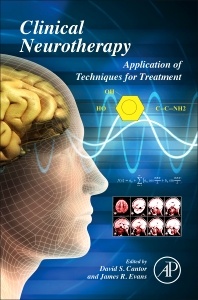Description
Clinical Neurotherapy
Application of Techniques for Treatment
Coordinators: Cantor David S., Evans James R.
Language: English
Subjects for Clinical Neurotherapy:
Keywords
ADHD; Antidepressants; Antipsychotics; Anxiolytics; Attention; Auditory visual stimulation; Autism; Binocular; Biofeedback; Brain mapping; Brain stimulation; CES; CNV; Computer-based cognitive training; Constipation; Cranial electrostimulation; Deep brain stimulation; Depression; Developmental disorders; Diet; Dual diagnosis; EEG; EEG biofeedback; Electroconvulsive therapy; Encopresis; Enuresis; Epilepsy; Ethics; Evidence-based medicine; Functional MRI; Genetics; Intellectual disability; LORETA; MRI; Mild traumatic brain injury; Neurofeedback; Neurofeedback therapist; Neurometrics; Neurotherapy; Neurotransmitters; Nutrigenomics; Nutrition; Operant conditioning; Orthoptic; PTSD; Pharmaco-EEG; Psychopharmacology; Psychosis; QEEG; Quantitative EEG; Repetitive transcranial magnetic stimulation; SCP training; SSVEP; Schizophrenia; Sleep; Socio-technical systems; Standard of care; Stimulants; Substance use disorder; TMS; Thought disorders; Treatment; Treatment effects; Treatment efficiency; Treatment success; VARETA; Vision therapy
448 p. · 15x22.8 cm · Hardback
Description
/li>Contents
/li>Readership
/li>Biography
/li>Comment
/li>
Neurotherapy, sometimes called EEG biofeedback and/or neurobiofeedback involves techniques designed to manipulate brain waves through non-invasive means and are used as treatment for a variety of psychological and medical disorders. The disorders covered include ADHD, mood regulation, addiction, pain, sleep disorders, and traumatic brain injury. This book introduces specific techniques, related equipment and necessary training for the clinical practitioner. Sections focus on treatment for specific disorders and which individual techniques can be used to treat the same disorder and examples of application and the evidence base for use are described.
1. Definitions, Standard of Care Issues, and Ethics - D. Corydon Hammond
2. An Introductory Perspective on The Emerging Application of qEEG in Neurofeedback - Richard Soutar
3. Neurofeedback and Psychopharmacology: Designing Effective Treatment Based on Cognitive and EEG Effects of Medications - Lukasz M. Konopka and Elizabeth M. Zimmerman
4. Hidden factors thwarting success: A Socio-Technical Field Theory Application for the Neurofeedback Therapist - Gerry Gluck
5. Defining Developing Evidence Based Methods (EBM) databases proving treatment efficiency - J. Lucas Koberda
6. Treating Attention Deficits and Impulse Control - Dagmar Timmers
7. Treating Mood Disorders - Emily Stevens
8. Treating Closed Head Injury - Carlos A. Novo-Olivas
9. Treating Thought Disorders - Tanju Surmeli
10. Treating Chronic Pain Disorders - Erbil Dursun and Nigar Dursun
11. Treating Addiction Disorders - Estate M. Sokhadze, David L. Trudeau, and Rex L. Cannon
12. Neurofeedback for Seizure Disorders: Origins, Mechanisms, and Best Practices - M.B. Sterman and Lynda Thompson
13. Diagnosing and Treating Developmental Disorders with QEEG and Neurotherapy - Teresa Bailey
14. Nutrition for ADHD and Autism - Jacques Duff
15. Neurotherapy: Complementary and Supplemental Technologies - John K. Nash
16. Future Considerations - Thomas F. Collura
Clinical psychologists, neuropsychologists, psychiatrists, neurologists, and professionals working in clinical and rehabilitation settings.
- An introduction for clinical practitioners and psychologists investigating neurotherapy techniques and application
- Includes coverage of common disorders such as ADHD, mood regulation, addiction, pain, sleep disorders, and traumatic brain injury
- Includes evidence base for use
- Includes training methods for new users




